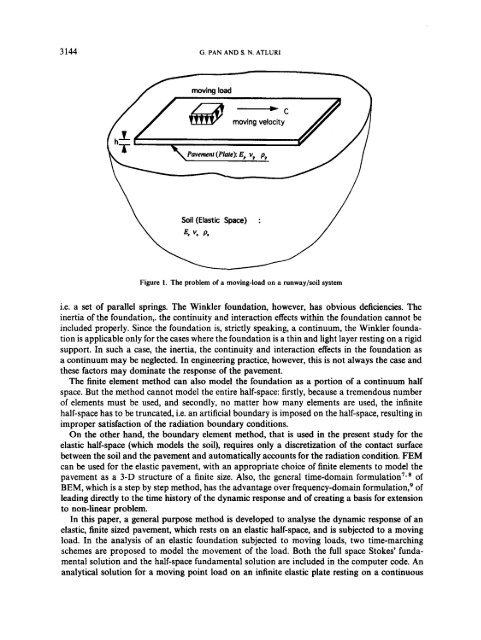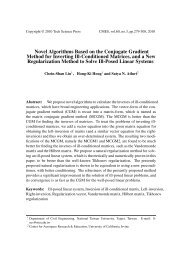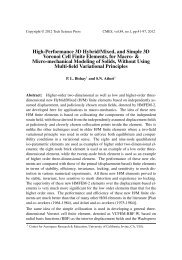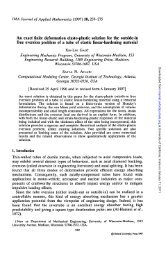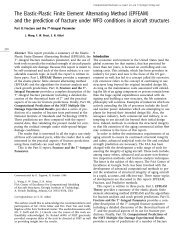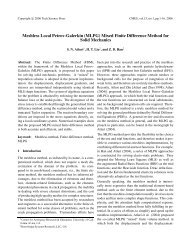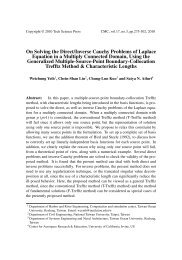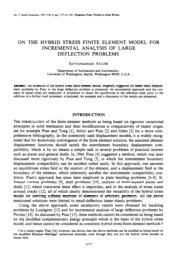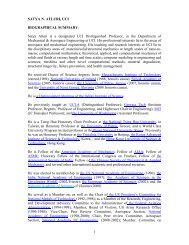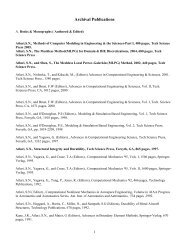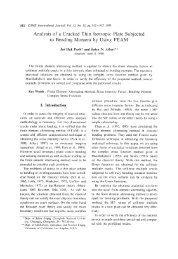Dynamic response of finite sized elastic runways subjected to ...
Dynamic response of finite sized elastic runways subjected to ...
Dynamic response of finite sized elastic runways subjected to ...
You also want an ePaper? Increase the reach of your titles
YUMPU automatically turns print PDFs into web optimized ePapers that Google loves.
3144 G. PAN AND S. N. ATLURI<br />
Pavement (Plate): E, vp pp<br />
Soil (Elastic Space)<br />
E* v, P.<br />
Figure 1. The problem <strong>of</strong> a moving-load on a runway/soil system<br />
i.e. a set <strong>of</strong> parallel springs. The Winkler foundation, however, has obvious deficiencies. The<br />
inertia <strong>of</strong> the foundation,. the continuity and interaction effects within the foundation cannot be<br />
included properly. Since the foundation is, strictly speaking, a continuum, the Winkler foundation<br />
is applicable only for the cases where the foundation is a thin and light layer resting on a rigid<br />
support. In such a case, the inertia, the continuity and interaction effects in the foundation as<br />
a continuum may be neglected. In engineering practice, however, this is not always the case and<br />
these fac<strong>to</strong>rs may dominate the <strong>response</strong> <strong>of</strong> the pavement.<br />
The <strong>finite</strong> element method can also model the foundation as a portion <strong>of</strong> a continuum half<br />
space. But the method cannot model the entire half-space: firstly, because a tremendous number<br />
<strong>of</strong> elements must be used, and secondly, no matter how many elements are used, the in<strong>finite</strong><br />
half-space has <strong>to</strong> be truncated, i.e. an artificial boundary is imposed on the half-space, resulting in<br />
improper satisfaction <strong>of</strong> the radiation boundary conditions.<br />
On the other hand, the boundary element method, that is used in the present study for the<br />
<strong>elastic</strong> half-space (which models the soil), requires only a discretization <strong>of</strong> the contact surface<br />
between the soil and the pavement and au<strong>to</strong>matically accounts for the radiation condition. FEM<br />
can be used for the <strong>elastic</strong> pavement, with an appropriate choice <strong>of</strong> <strong>finite</strong> elements <strong>to</strong> model the<br />
pavement as a 3-D structure <strong>of</strong> a <strong>finite</strong> size. Also, the general time-domain formulation'^* <strong>of</strong><br />
BEM, which is a step by step method, has the advantage over frequency-domain form~lation,~ <strong>of</strong><br />
leading directly <strong>to</strong> the time his<strong>to</strong>ry <strong>of</strong> the dynamic <strong>response</strong> and <strong>of</strong> creating a basis for extension<br />
<strong>to</strong> non-linear problem.<br />
In this paper, a general purpose method is developed <strong>to</strong> analyse the dynamic <strong>response</strong> <strong>of</strong> an<br />
<strong>elastic</strong>, <strong>finite</strong> <strong>sized</strong> pavement, which rests on an <strong>elastic</strong> half-space, and is <strong>subjected</strong> <strong>to</strong> a moving<br />
load. In the analysis <strong>of</strong> an <strong>elastic</strong> foundation <strong>subjected</strong> <strong>to</strong> moving loads, two time-marching<br />
schemes are proposed <strong>to</strong> model the movement <strong>of</strong> the load. Both the full space S<strong>to</strong>kes’ fundamental<br />
solution and the half-space fundamental solution are included in the computer code. An<br />
analytical solution for a moving point load on an in<strong>finite</strong> <strong>elastic</strong> plate resting on a continuous


